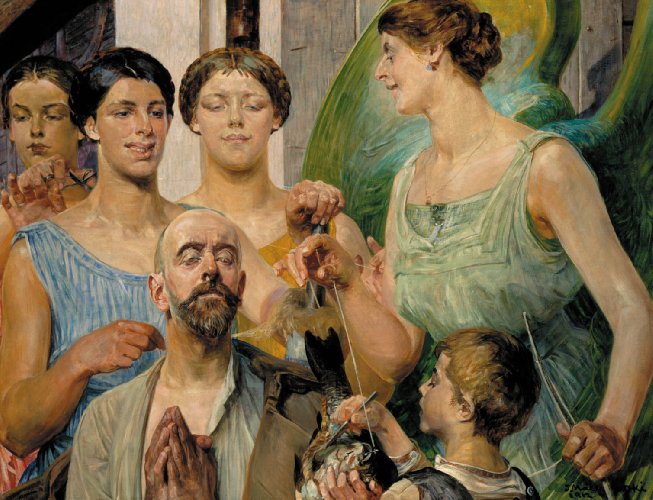Description:
Jacek Malczewski (1854-1929) had a deep love for art and romantic literature, especially the poetry of Juliusz Słowacki, from his family home. He came from a noble, but not wealthy family. His father, Julian, supported his career as a painter. The events of 1863, the January Uprising and subsequent repression, had a particularly strong impact on the young artist. His first teacher was Adolf Dygasiński. He spent his youth from 1867-1871 at the Karczewski Manor in Wielgie. In 1873 he began studying at the Academy of Fine Arts in Krakow under the tutelage of Jan Matejko. He was a student of Władysław Łuszczkiewicz. He also studied at the École des Beaux-Arts in Paris. He traveled to Italy, Vienna, Munich, Greece, and Minor Asia. From 1896-1900 and 1910-1914, he was a professor at the Academy of Fine Arts in Krakow. From 1912-1914 he was its rector. His work began with idealizing realism and then naturalism, with the main theme of his work during this period being the fate of exiles to Siberia and the inspiration of “Anhellim” by Juliusz Słowacki. At the same time, fantastic and allegorical approaches began to appear in Malczewski’s work. After his father’s death in 1884, the recurring theme in Malczewski’s work was Thanatos – the god of death. After 1890, his art became completely symbolic. Works manifesting the turn towards the style of symbolism are “Introduction” 1890, “Melancholy” 1890-1894, “Vicious Circle” 1895-1897. The artist addressed existential, historical and artistic topics. He intertwined classical and biblical motifs with native folklore and the Polish landscape, so important in his works. Form, color, monumentality of representations and their expressiveness became his signature.
Description of the painting:
The young Polish artist Jacek Malczewski often combined two timeless themes in his work: biblical and mythological. Combining these two spheres was intended to be an expression of the complexity of the world around us. An example is the canvas Tobiasz and the Fates, which refers to the Old Testament story of Tobias and the mythological ladies of human fate.
According to the Old Testament, one evening Tobias was resting, sitting under the wall of his house. At some point bird droppings fell on Tobias’ eyes and his eyes were covered with a white film. Despite the treatment, Tobias lost his sight. The situation was so difficult for him that he began to pray for death. God heard Tobias’ prayer and sent the Archangel Raphael to him. Meanwhile, Tobias told his son, also called Tobias, to go to Media and settle old debts. In order to not travel alone, the young man was looking for a travel companion. Raphael offered his help, but did not reveal to the boy who he was. Before the expedition, the elder Tobias wanted to meet the man with whom his son was to go on a journey. Upon learning that the companion came from the people of Israel, he allowed them to set off. During the journey, during one of the stops, Tobias decided to bathe in a river. When the young man was bathing, a large fish attacked him. The Archangel ordered the boy to catch the fish, and when they had captured the fish, Raphael commanded his companion to split the fish and take out the gall, heart and liver and keep them. The heart and liver were used to drive away the evil spirit from the body of Sarah, a relative of Tobias who lived in Media. Sarah’s father, in gratitude, gave his daughter’s hand to the young man. When the younger Tobias returned home, he took the fish gall with him, as the Archangel had commanded him earlier, and rubbed his father’s eyes with it. And a miracle happened – the elder Tobias regained his sight.
And what do we know about the title fates? The ancient Greeks believed that destiny was in control of everything and that neither people nor gods could oppose it. The power over it was supposed to be held by three daughters of the night called Moirai, or in Roman mythology – the Fates. They were named Cloto, Lachezis and Atropos. The three of them had to spin the thread of human life, which was cut at the moment of death by the oldest Atropos. They were imagined as three old women with a spindle in their hands and a weighing scale or roll of papyrus, on which they wrote the destiny of each person.
The theme of Tobias in the paintings of Malczewski appeared several times. Here, it is presented in a new, individual realization of the artist. Tobias expresses moral steadfastness and loyalty to his nation in this representation. He is waiting for miraculous healing through the medicine brought by his son. The Fates (young, strong women) standing behind Tobias spin the thread of life, to which the female, green-winged Archangel Raphael, with features reminiscent of Malczewski’s muse, Maria Balowa, intervenes. Atropos cannot cut the thread. By painting the faces of specific people on the figures, the painter gave the universal content a more personal character. The picture becomes a portrait of the Malczewski family, in which the father, Julian, had many years of his life taken away by the Tsarist repression.


